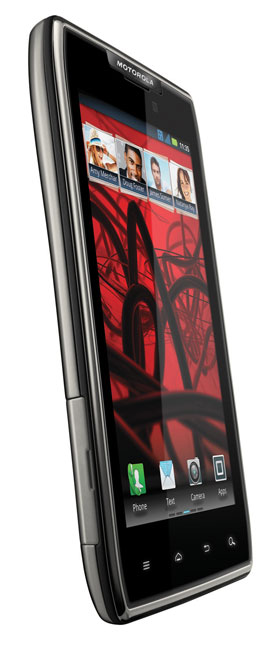 Like last year’s Razr, Motorola’s updated Razr Maxx is an elegant and potent device. The Maxx sacrifices the slim profile of its predecessor in exchange for a mammoth 3 300mAh battery, and that is really where it’s looking to differentiate itself from rival top-end Android handsets.
Like last year’s Razr, Motorola’s updated Razr Maxx is an elegant and potent device. The Maxx sacrifices the slim profile of its predecessor in exchange for a mammoth 3 300mAh battery, and that is really where it’s looking to differentiate itself from rival top-end Android handsets.
With the Maxx, Motorola is clearly hoping that outlasting the competition in terms of stamina will be enough to get consumers to open their wallets to it.
At first glance, the Maxx is almost indistinguishable from its predecessor, which was a phone we really liked. It has the same 4,3-inch, 540×960-pixel Corning Gorilla Glass “super Amoled” display, powered by the same dual-core 1,2GHz processor and 1GB of RAM.
Both devices offer 16GB of onboard memory and the option to expand this by an additional 32GB via microSD. Both include 8-megapixel rear-facing cameras and 1,3-megapixel front-facing ones (though the Maxx’s secondary shooter can now do video, too), and both have Kevlar-fibre reinforced backs and non-user-removable batteries.
Aside from the fact that the Maxx is 8,99mm thick and 147g compared to its 7,1mm and 127g forerunner, there’s almost nothing between them.
Unfortunately, that includes the operating system. The original Razr shipped with Android 2.3.5 which was later upgradeable to 2.3.6. The Maxx ships with 2.3.6 and, although it claims an update for Android 4.0 is coming, it’s yet to arrive.
The lack of the latest and greatest in Android operating systems lets the Maxx down a bit. It’s not that 2.3 is bad by any measure, it’s just that the sort of consumers considering the Maxx will also be looking at Samsung’s Galaxy S3 and HTC’s One X, both of which run the latest version of Android, also known as Ice Cream Sandwich.
We rather like Motorola’s handling of its Android overlay — it’s understated and adds some great functionality through widgets like its quick-dial/contact widget that shows four users on the home screen but expands to fill the screen with 20 dragged down with a finger.
We also like the fact that it’s becoming increasingly common for Android phones to include support for streaming over protocols like DLNA — as in the case of the Motorola. There’s also HDMI-out via a micro-HDMI port. With cameras getting better with every release and handsets becoming portable entertainment devices, these sorts of additions are becoming more functional and less gimmicky.
Our only serious complaint about the Razr was the fact that its battery life was — like many of its contemporaries — pretty poor. Motorola hasn’t only sought to rectify this with the Maxx, it’s tried to make battery longevity the device’s primary selling point.
 The Maxx’s enormous battery does what it’s meant to — the phone lasts for ages. It’s possible to get two days of regular use out of it. You’d be hard-pressed to find an international flight that would be able to flatten it before you’d got tired of watching videos or listening to music on it.
The Maxx’s enormous battery does what it’s meant to — the phone lasts for ages. It’s possible to get two days of regular use out of it. You’d be hard-pressed to find an international flight that would be able to flatten it before you’d got tired of watching videos or listening to music on it.
Last year’s Razr was excellent in terms of interface, features and price. The Maxx is even better. It’s R500 cheaper at R6 500 and lasts so much longer.
However, it’s a pity that the screen didn’t get an update in the process. It’s a respectable display, and when the first Razr came out it was bordering on exceptional, but now it’s simply not up to the standard set by rival manufacturer’s flagship devices.
This may seem like nitpicking, but many consumers planning to spend the sort of money involved here will be doing just that. The Maxx is also heavier than many of its rivals, but we found that reassuring and a reminder of the superb build quality of the device. Also, a little bit of added heft is a small price to pay for the enormous additional battery life.
There’s a great heritage and pedigree to Motorola’s Razr range, but as Nokia has demonstrated with aplomb, heritage is worth little in the fast-moving mobile phone market. Ultimately, that’s the problem with Motorola’s latest offering – aside from the battery, the Maxx doesn’t do enough to push the envelope.
This is a perfectly capable and attractive device, but with companies like Samsung buying every spare billboard around town, good looks and stamina may not be enough to secure the attention and loyalty of consumers.
One does, however, have to admire Motorola’s persistence. The Maxx deserves to sell by the bucket-load. It probably won’t, but let’s hope Motorola keeps at it. — (c) 2012 NewsCentral Media




